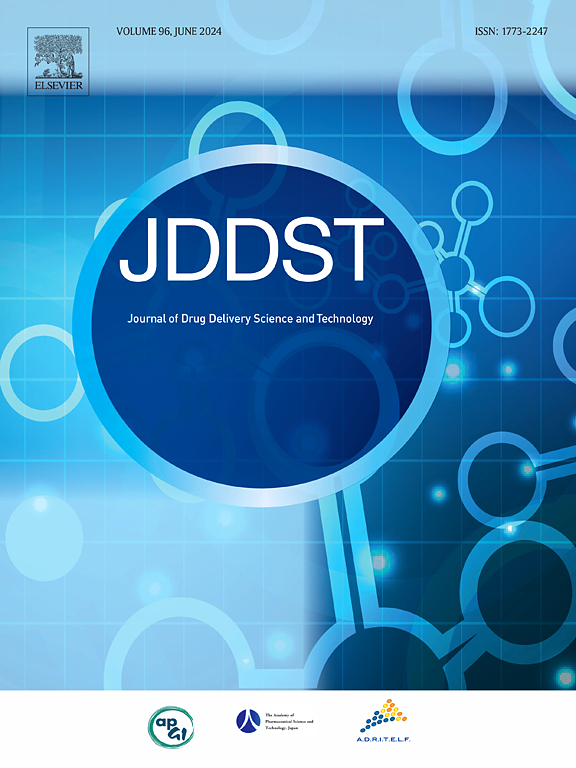纳米硒壳聚糖反胶束调控药物传递的抗癌潜力
IF 4.5
3区 医学
Q1 PHARMACOLOGY & PHARMACY
Journal of Drug Delivery Science and Technology
Pub Date : 2025-03-27
DOI:10.1016/j.jddst.2025.106860
引用次数: 0
摘要
将纳米粒子与生物聚合物保护涂层相结合是一种极具吸引力的癌症治疗策略。本研究利用双(2-乙基己基)磺基琥珀酸钠(AOT)和N-十六烷基-N,N,N-三甲基溴化铵(CTAB)等表面活性剂,通过反向胶束法开发了壳聚糖(CS)包被硒(Se)纳米载体,以增强达柔比星(DNR)的持续释放并提高药物载体的稳定性。经化学还原的 Se 纳米粒子聚集成直径约为 60 nm 的细长棒状,在其表面涂上 CS,形成一层保护层,从而保持药物的持续释放。Zeta 电位测量显示,CS 涂层增加了 Se 纳米粒子的表面电荷,CTAB 系统的表面电荷值为 33 ± 6.1 mV,AOT 系统的表面电荷值为 30 ± 5.7 mV。此外,与 CTAB(62%)相比,AOT 的封装效率更高(70%)。在 pH 值为 5.4 时,DNR 药物的累积释放率(88%)明显高于 pH 值为 7.4 时的释放率(75%),这表明药物的释放行为与 pH 值有关。CS 涂层起到了守门员的作用,调节了 DNR 从 Se 纳米粒子中的释放。体外研究表明,与裸 Se 纳米粒子相比,CS-CTAB-Se@DNR 和 CS-AOT-Se@DNR 载体都表现出更高的细胞毒性和更多的 ROS 生成。这些发现凸显了 CS-Se@DNR 纳米载体作为一种有效的癌症治疗策略的潜力。本文章由计算机程序翻译,如有差异,请以英文原文为准。

Modulating drug delivery with nano-selenium capped chitosan reverse micelles for anticancer potential
Combining nanoparticles with biopolymer protective coatings offer an appealing cancer treatment strategy. This study develops chitosan (CS) coated selenium (Se) nanocarriers via reverse micellar method using surfactants such as sodium bis(2-ethylhexyl)sulfosuccinate (AOT) and N-cetyl-N,N,N-trimethylammonium bromide (CTAB) to enhance the sustained release of daunorubicin (DNR) and to improve the stability of drug carriers. The chemically reduced Se nanoparticles aggregated into elongated rod shapes, approximately 60 nm in diameter, and were coated with CS to form a protective layer that sustained the drug release. Zeta potential measurements revealed that CS coating increased the surface charge of Se nanoparticles, with values of 33 ± 6.1 mV for CTAB system and 30 ± 5.7 mV for AOT systems. Additionally, AOT resulted in higher encapsulation efficiency (70 %) compared to CTAB (62 %). DNR drug release at pH 5.4 showed a significantly higher cumulative release (88 %) compared to pH 7.4 (75 %), demonstrating pH-dependent release behavior. The CS coating acts as a gatekeeper, regulating the release of DNR from Se nanoparticles. In vitro studies showed that both CS-CTAB-Se@DNR and CS-AOT-Se@DNR carriers exhibited higher cytotoxicity and increased ROS generation compared to bare Se nanoparticles. These findings highlight the potential of CS-Se@DNR nanocarriers as an effective strategy for cancer treatment.
求助全文
通过发布文献求助,成功后即可免费获取论文全文。
去求助
来源期刊
CiteScore
8.00
自引率
8.00%
发文量
879
审稿时长
94 days
期刊介绍:
The Journal of Drug Delivery Science and Technology is an international journal devoted to drug delivery and pharmaceutical technology. The journal covers all innovative aspects of all pharmaceutical dosage forms and the most advanced research on controlled release, bioavailability and drug absorption, nanomedicines, gene delivery, tissue engineering, etc. Hot topics, related to manufacturing processes and quality control, are also welcomed.

 求助内容:
求助内容: 应助结果提醒方式:
应助结果提醒方式:


